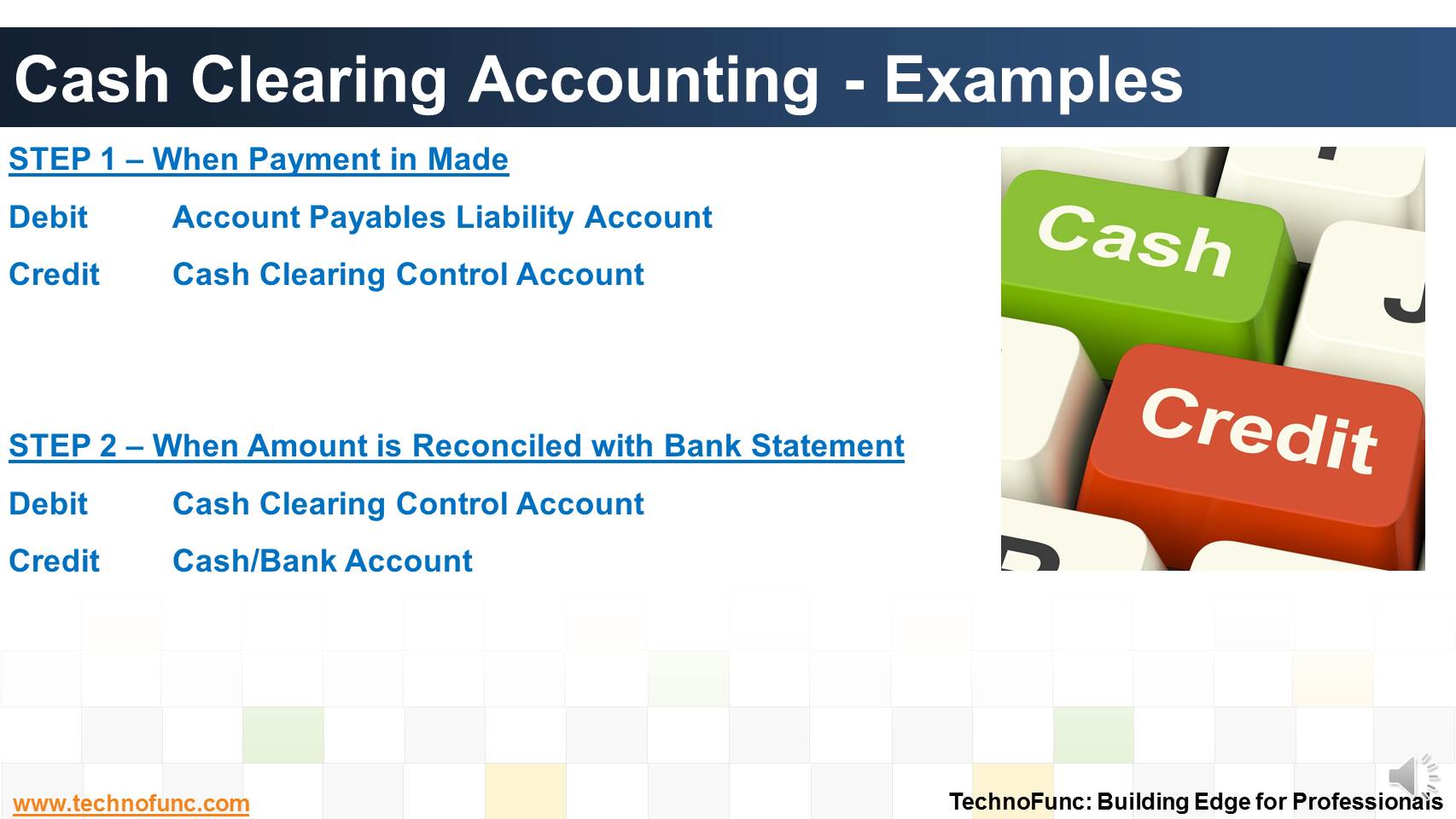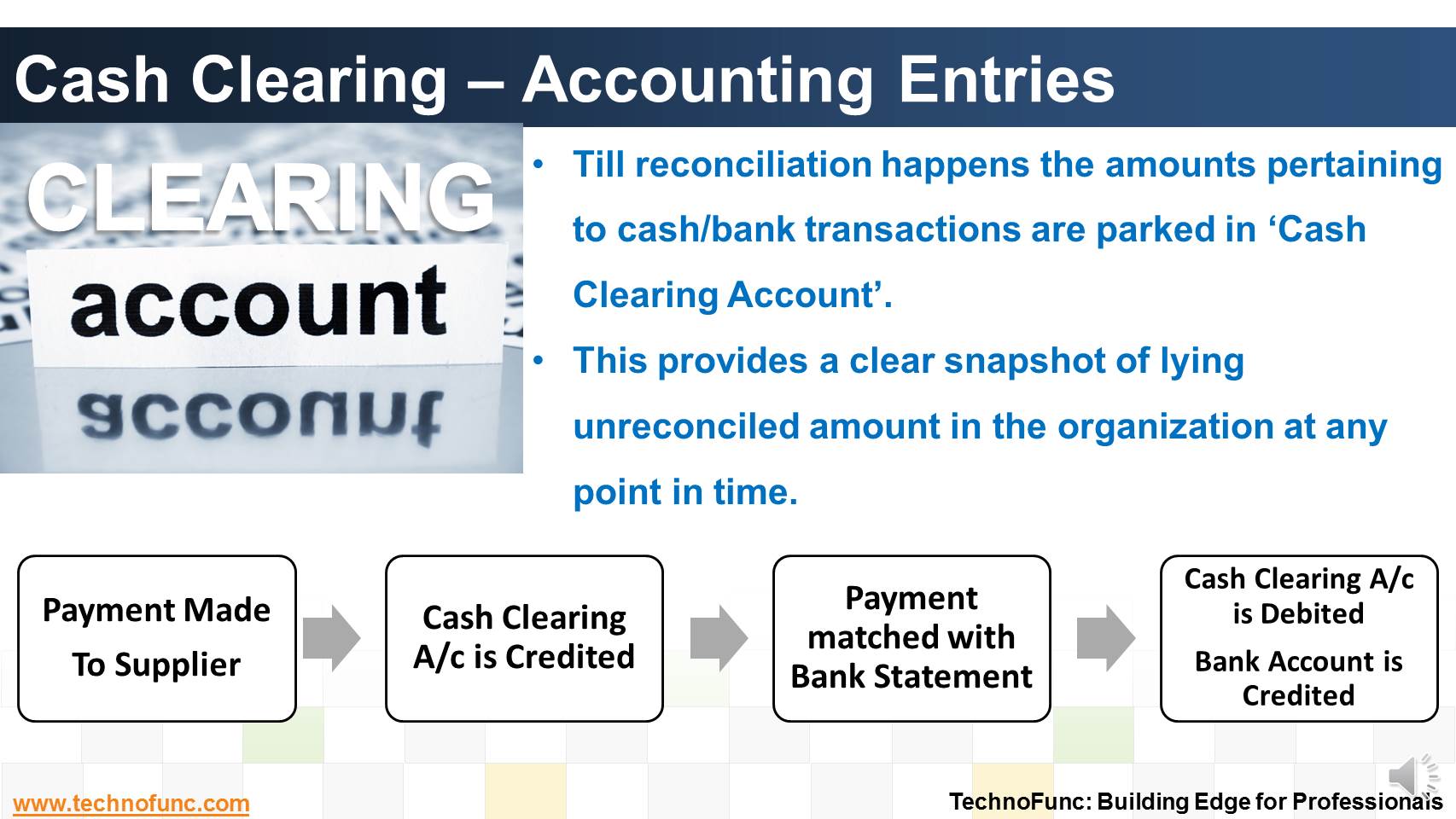- Home
- Business Processes
- Industry Knowledge
- Aerospace Industry
- Automotive Industry
- Banking Domain
- BFSI Industry
- Consumer/ FMCG Industry
- Chemicals Industry
- Engineering & Construction
- Energy Industry
- Education Domain
- Finance Domain
- Hospitality Domain
- Healthcare Industry
- Insurance Domain
- Retail Industry
- Travel and Tourism Domain
- Telecom Industry
- Leadership Skills
- eLearning
- Home
- Functional
- Cash Management
- Cash Clearing – Accounting Entries
Cash Clearing – Accounting Entries
The Cash Clearing process enables you to track amounts that have actually cleared your bank. Learn the steps and accounting entries that gets generated during the cash clearing process.
Cash Clearing Account
Till reconciliation happens the amounts pertaining to cash/bank transactions are parked in 'Cash Clearing Account'.
This method focuses on the use of a special cash-clearing control account to help provide an accurate cash-on-hand balance by including the effect of cash/bank transactions that have been issued, but have not yet cleared the bank in reconciliation system.
This provides a clear snapshot of lying unreconciled amount in the organization at any point in time.
For example – when you release payment to any supplier for his due invoice
You typically Dr Supplier A/c and Credit Bank Account
However in Cash Clearing Method – when you issue payment
You will Dr Supplier A/c and Credit Cash Clearing Account
Later when you receive the bank statement and reconcile the payment – at that point you will generate another accounting entry:
That is Cash Clearing A/c is Debited and Bank Account is Credited
Hence at this stage the payment hits your bank account – keeping it always reconciled.
Accounting Entries – Cash Clearing Process
The Cash Clearing process creates accounting entries for each scheduled payment that has been paid, reconciled, and cleared for bank accounts using cash clearing method of reconciliation.
These accounting entries are then posted to the general ledger.
Cash/Bank Clearing account is used to record unidentified debits and credits in bank statement.
At the time of reconciliation process, we have to debit or credit main account and offsetting will be done to Cash/Bank Clearing account.
Then only balance in the main account will match with Bank Statements.
Cash Clearing Accounting Examples
Cash clearing accounting for cash/bank transactions is a two-step process.
Step 1
When the payment is issued and posted, the accounts payable liability account is debited, and the cash clearing control account (as opposed to the actual cash account) is credited for the payment amount.
Step 2
Later, when the cash clearing request is processed, a pair of balanced accounting entries are created to clear the net cash amount of the issued payment for each payment that has been reconciled.
To determine the actual cash balance, add any debit or credit residue in the cash clearing control account from payment or deposit amounts that have not yet been cleared to the cash account balance.


Related Links
You May Also Like
-
Complete Bank Reconciliation Process
Bank Reconciliation Process is a eight step process starting from uploading the Bank Statement to finally posting the entries in General Ledger. Learn the Eight Steps in Detail!
-
Introduction to Bank Reconciliation Process
These set of articles provide a brief introduction to Bank Reconciliation Process. This topic not only discusses the meaning of bank reconciliation process but also discusses how this process in handled in new age ERPs and Automated Reconciliation Systems.
-
So many codes in the lines that are there in a Bank Statement. It contain lots and lots of meaningful information that can help automated many tasks. Explore more!
-
Before we dive into cash management, let us fist understand what we mean by cash and what constitutes cash in context of cash management process.
-
The objective of Financial risk management is to protect assets and cash flows from any risk. Treasury function works to accurately assess financial risks by identifying financial exposures including foreign exchange, interest rate, credit, commodity and other enterprise risks. Learn about the various risks that are managed by treasury.
-
Technology has enabled the treasury function by providing various solutions to manage it's complicated tasks. This article explains various types of treasury management systems available in the market.
-
Treasury has increasingly become a strategic business partner across all areas of the business, adding value to the operating divisions of the company. Managing activities that were traditionally carried out within the general finance function. Learn about the drivers for this change.
-
Cash Management - Integrations
Cash Management integrates cash transactions from various sources like Receivables, Payables, Treasury and creates reconciliation accounting entries after matching transactions with Bank Statements.
-
Unravel the mystery behind clearing. Why we use clearing accounts. Find the relevance of word "Clearing" in business context.
-
Bank reconciliation process is targeted to validate the bank balance in the general ledger and explain the difference between the bank balance shown in an organization's bank statement. Learn the reasons for existence of differences between the two.
Explore Our Free Training Articles or
Sign Up to Start With Our eLearning Courses

About Us
Learning
© 2023 TechnoFunc, All Rights Reserved











